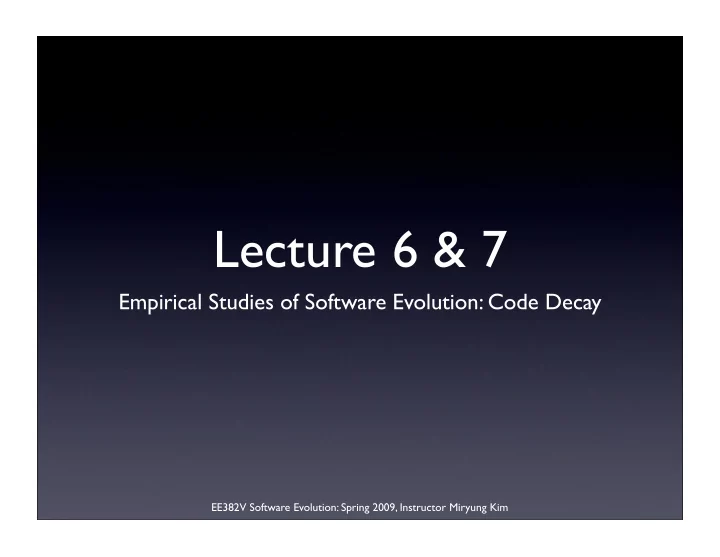

Lecture 6 & 7 Empirical Studies of Software Evolution: Code Decay EE382V Software Evolution: Spring 2009, Instructor Miryung Kim
Announcement • Your proposals have been graded. • Literature Survey & Tool Evaluation: Each in the range of 1-4 • Project Proposal: Each in the range of 1-8 EE382V Software Evolution: Spring 2009, Instructor Miryung Kim
Today’s Agenda • Divya’s presentation on the code decay paper • Discuss Belady & Lehman’s paper • Discuss Code Decay paper • Q and A session on my feedback to your proposals EE382V Software Evolution: Spring 2009, Instructor Miryung Kim
Today’s Presenter • Divya Gopinath (Skeptic) EE382V Software Evolution: Spring 2009, Instructor Miryung Kim
A Model of Large Software Development • L.A Belady and M.M Lehman • 1976 • IBM OS/360 • Seminal empirical study paper in software evolution EE382V Software Evolution: Spring 2009, Instructor Miryung Kim
What was it like in 1976? • IBM PC came out around 1984 • Apple introduced PC in 1970s • EE382V Software Evolution: Spring 2009, Instructor Miryung Kim
What was it like in 1976? • E.W. Dijkstra: a program must as a mathematical theorem should and can be provable • Increasing cost of building and maintaining software was alarming EE382V Software Evolution: Spring 2009, Instructor Miryung Kim
Subject Program & Data • OS/360 • 20 years old • 20 user-oriented releases • Starting with the available data, they attempted to deduce the nature of consecutive releases of OS/360 EE382V Software Evolution: Spring 2009, Instructor Miryung Kim
When observing software evolution, what can you measure? • # of bugs (reported problems) • # of modules => # of directories, # of files • performance metrics => times, memory usage, CPU usage, IPC • change types: corrective, adaptive, perfective • # of developers working in the organization, # of deveopers per module • size of code changes => # of lines of changed code • how wide spread the changes are => # of files or modules touched by the same change • age in calendar year, days, months / age in logical unit such as release, check-in, version EE382V Software Evolution: Spring 2009, Instructor Miryung Kim
Variables observed in Belady and Lehman 1976 • The release number • Days between releases • The size of the system • The number of modules added, deleted, and changed • Complexity: the fraction of the released system modules that were handled during the course of release MH_r / M_r • Manpower, machine time, and costs involved in each release EE382V Software Evolution: Spring 2009, Instructor Miryung Kim
Growth Trends of System Attribute Counts With Time Figure 1 Growth trends of system attribute counts with time COMPONENTS MODULES HANDLED . TIME The scientific method has made progress in revealing the nature Figure 2 Average growth trends of system attributes of the physical world by pursuing courses other than studying EE382V Software Evolution: Spring 2009, Instructor Miryung Kim individual phenomena in exquisite detail. Similarly, a system, a process, or a phenomenon may be viewed from the outside, by acts of observing; clarifying; and by measuring and modeling identifiable attributes, patterns, and trends. From such activities one obtains increasing knowledge and understanding, based on the behavior of both the system and its subsystems, the process and its subprocesses. I AVERAGE RELEASE SEQUENCE NUMBER Starting with the initial release of os/360 as a base, we have LEGEND: 0 SIZE IN MODULES studied the interaction between management and the evolution X MODULES HANDLED +RELEASE INTERVAL of os/360 by using certain independent variables of the improve- ment and enhancement (i. e., maintenance) process. We cannot say at this time that we have used all the key independent vari- ables. There is undoubtedly much more to be learned about the variables and the data that characterize the programming pro- cess. Our method of study has been that of regression-outside in-which we have termed “structured analysis.” Starting with nature of the available data, we have attempted to deduce the consecutive releases of os/360. We give examples of the data 226 BELADY AND LEHMAN IBM SYST J
Recommend
More recommend